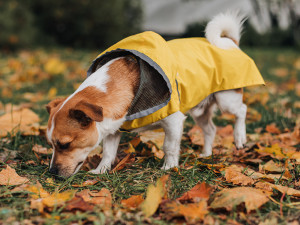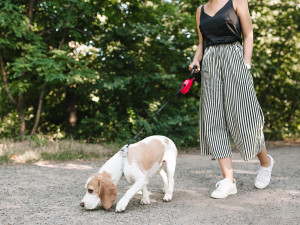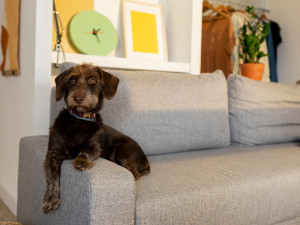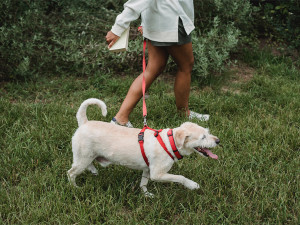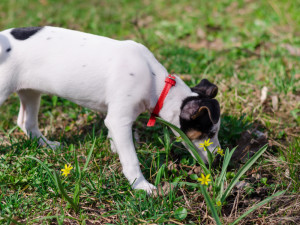How to Teach Your Dog Scent Training at Home: A Step-by-Step Guide
Aside from being cool, your dog’s super scent-sniffing abilities are good for their mental health.

Share Article
In This Article:
Why Scent Training Is Beneficial for Dogs Getting Started with Scent Training Basic Scent-Training Exercises Advanced Scent-Detection Tasks Tips and Tricks for Successful Scent Training
Have you ever marveled at your dog’s ability to sniff out the exact location of a rogue piece of popcorn under the couch? That superpowered snout isn’t just cute: It’s a fine-tuned sensory instrument capable of detecting scents at one part per trillion. Scent training takes that natural talent and gives it structure, turning everyday sniffing into an enriching, mentally stimulating activity that any dog can enjoy, right in your living room.
Scent training isn’t just for bomb-sniffing German Shepherds or truffle-hunting terriers. It’s accessible, low-cost, and shockingly fun for you and your pup. Whether you’re working with a high-energy Border Collie, a scent-savvy Beagle, or a couch-loving Pomeranian, scent training builds confidence, eases anxiety, and strengthens the bond between you and your dog…one sniff at a time.
How much do you spend on your pet per year?

Why scent training is beneficial for dogs
Think of scent training as Sudoku for your dog’s nose. It’s mental enrichment, stress relief, and confidence-building rolled into one sniff-tastic game. Dogs are born sniffers, and their noses are their superpowers.
While we’re over here smelling pizza, they’re detecting the oregano, cheese, and the fact that your neighbor added garlic and anchovies. That’s how powerful their senses of smell are. They can detect individual scents through a combination of aromas.
Alexandra Horowitz, the head of the Dog Cognition Lab at Barnard College in New York, says, “Let them sniff. Their world is made of more scents than sights.”
Scent work taps into a dog’s primal abilities, channeling them in ways to satisfy their instincts. It gives nervous dogs something empowering to focus on, allows energetic dogs to have a job, and bestows on senior dogs a gentle way to stay mentally keen. The best part is that it’s fun, like a treasure hunt (minus the pirates).
What makes scent training so engaging for dogs (and fun for humans)?
Scent training is one of the most instinctually rewarding things your dog can do. From the moment they come into the world, dogs explore primarily through scent. Their noses are wired for discovery, decoding the world through layers of aroma like we decode meaning from words.
Tapping into that ability is like turning on a lightbulb in their brains. Suddenly, your dog isn’t just sniffing the floor. They’re working a case, solving a puzzle, and doing a job.
For us humans, there’s something satisfying about watching dogs work toward a hidden treat with purpose and excitement. It transforms you from “the treat dispenser” to “the mission commander,” giving you both a reason to cheer every minor success. Whether hiding a smelly snack behind a curtain or laying out a scent trail in your backyard, scent training shifts energies away from anxiety, boredom, or mischief, channeling it into something healthy and productive.
Scent training builds confidence and happiness through simple wins. It’s training, play, bonding, and excitement. And you? You’ll find yourself noticing your dog’s cues, reading their body language better, and becoming a more engaged pet parent in everyday adventures.
Getting started with scent training
Before you start tossing kibble behind the couch cushions, let’s talk setup. Excellent scent training begins with three simple steps.
1. Appealing scent
This is your dog’s favorite bribe. Choose something that makes their eyes light up and their tail go turbo. Think smelly treats like freeze-dried liver, peanut butter bits, or shredded chicken. The stinkier, the better. If it makes you wrinkle your nose, your dog will probably love it.
2. Use containers or scent boxes
You don’t need pro gear. Grab what you’ve got: muffin tins, cardboard boxes, Tupperware, or even solo cups. Anything you can hide a treat under or inside will work. Ensure your dog uses their nose, not their eyes, to solve the puzzle.
3. Quiet space
Distractions are the enemy of good sniffing. Start somewhere calm, like a bedroom or a low-traffic corner of your living room. No loud TV, no bouncing kids, and no cats trying to sabotage the training session.
Basic scent-training exercises
Ready to let your dog’s nose shine? These beginner-friendly games are an excellent way to kick things off and build sensory confidence.
Scent introduction
This is your dog’s “meet and greet” with the scent. Let them sniff it up close: a treat, a toy, or a scented cotton ball. Use your chosen cue, such as “find it” or “go sniff,” and then reward them with a treat. Keep it casual and encouraging. This is the sniffing equivalent of a first date, just an introduction.
Find the treat game
Think of this as hide-and-sniff. Place a treat in plain sight behind a chair leg or under a blanket corner. Once they’ve got the hang of it, up the challenge: new spots, multiple treats, even other rooms. It’s like an Easter egg hunt with beef jerky (or other delicious doggy snacks).
Scent box game
Line up three to five boxes, but only one gets the smelly prize. Your dog’s job is to find the jackpot. As they improve, shuffle the boxes, add decoys, or increase the number. Watch them start to problem-solve, Sherlock Holmes-style.
Advanced scent-detection tasks
Once your dog’s nose is locked in, it’s time to go pro. These next-level games mimic real-life detection tasks, minus the crime scenes.
Room search: Hide the scent in a bigger room, and let your dog go into detective mode. Tuck it behind pillows, under tables, or in weird corners. The moment they lock onto the scent, it’s an instant reward.
Outdoor scent work: Time to take the sniffer outside. Hide treats in the yard or along a walking trail (safely and responsibly). Outdoor smells are a buffet for your dog’s nose, so keep the sessions short and on-leash to begin with. They need control to adjust to the extra noise and sensory clutter.
Scent trails: Drag a treat across the floor or lawn to create a scent path, then challenge your dog to follow it to the prize. Start with short trails, then increase the distance and throw in twists and turns. It’s like laying down a breadcrumb trail for your pup to navigate.
Tips and tricks for successful scent training
Want to keep your dog motivated and focused during scent training? Here’s how to turn your sniff sessions into smashing successes, one enthusiastic tail wag at a time.
Positive reinforcement
If your dog believes that sniffing leads to amazing rewards, they’ll always have their nose turned on. Use what your dog loves most: high-value treats, a favorite toy, verbal praise, or that squeaky voice you swore you’d never use in public.
For food-motivated dogs, break treats into smaller pieces so you can reward frequently without overfeeding. For play-driven pups, a quick tug or ball toss can be a jackpot.
The golden rule is always to reward effort, not perfection. If your dog misses the mark, don’t scold. Redirect and cheer on the next try. This is supposed to be fun, not quiz week.
Training sessions
Short and consistent wins the race. Keep sessions to five to 10 minutes, and end on a success, even a minor one. If your dog finds a treat quickly, don’t immediately dive into something more challenging. Celebrate and finish the session on a high note.
Celebration and praise build your dog’s confidence, making them excited for the next training session. If your pup loses interest, they’re probably tired or overstimulated. Take a break and try again later.
Increase difficulty
Once your pup is crushing the basics, level up gradually. Start using new rooms, swap scent containers, or introduce decoy boxes. Try placing the scent on a chair, shelf, or behind a curtain to vary the search dynamics. The goal is to stretch your dog’s brain without overwhelming them. It should be challenging but satisfying.
As your dog builds confidence, you can also experiment with layering distractions into their search environment. Try hiding the scent while a TV is playing, during a mealtime hustle, or when another person is in the room. You can vary the scent source itself by switching from food to a toy or introducing a completely new smell.
Routine training
Scent work doesn’t need to be a performance. Slip it into your day — like before meals, after walks, or when rain ruins your puppy-park plans. Consistent practice builds skill, focus, and gives your dog a job that doesn’t involve destroying your favorite pair of shoes out of boredom.
Bottom line
Scent training unlocks your dog’s natural intelligence and curiosity.
Whether you’re navigating treat-stuffed puzzle boxes or laying intricate scent trails in the yard, each session builds confidence and focus.
It also strengthens the trust between you and your pup.
Best of all, it fits into real life. You don’t need professional equipment or hours of free time, just a few treats, some creativity, and the willingness to let your dog lead with their nose.
References
“Development of an Automated Human Scent Olfactometer and Its Use in the Training of Detection Dogs.” PLOS ONE, vol. 18, no. 3, 2023. doi.org/10.1371/journal.pone.0299148opens in new tab.
“Dog Training Tips.” Virginia-Maryland College of Veterinary Medicine. vetmed.vt.edu/news/2023/dog-training-tips.htmlopens in new tab.
Duranton, C., and A. Horowitz. “Let Me Sniff! Nosework Induces Positive Judgment Bias in Pet Dogs.” Applied Animal Behaviour Science, vol. 211, 2019, pp. 61–66. doi.org/10.1016/j.applanim.2018.12.009opens in new tab.
“Training Methodology for Canine Scent Detection of a Critically Endangered Species.” Journal of Vertebrate Biology, vol. 69, no. 3, 2020. doi.org/10.25225/jvb.20092opens in new tab.
“Transitioning from Training to Testing with Scent Detection Animals.” Journal of Veterinary Behavior, vol. 56, 2022, pp. 1–7. doi.org/10.1016/j.jveb.2022.04.001opens in new tab.

Valerie Mellema
Valerie Mellema has a Bachelor of Science in Agribusiness and Equine Industry from West Texas A&M University. She has been a professional writer for the past 20 years, covering a wide variety of pet health and care topics before founding a nonprofit focused on mental health in children and thoroughbred aftercare. She has four Border Collies and eight retired racehorses.
Related articles
![Woman in vintage striped pants walking in park while her pet is following the trail. Cute beagle dog sniffs something on the path in morning.]()
Does Your Dog Have a Nose For Scent Training?
This sounds like a competition show waiting to happen.
![Dark brown dog sitting on a gray couch in a living room]()
Turns Out Dogs Can Tell, Er, Smell Time
There’s no time like the present, according to your pet.
![A woman with a book in her hand walking her dog on a leash in a grassy park.]()
Why You Should Take Your Pup on a “Scent Walk”—All the Dogs Are Doing It
Why you should let your dog get all their sniffs out on a stroll.
![Woman and dog in lavender field.]()
Dogs Have Favorite Scents, Study Says—And No, It’s Not Just the Smell of Food
So, go ahead and get that lavender-scented candle.
![A little puppy Jack Russell terrier is smelling the grass in the park with red dog-collar.]()
On Your Next Walk, Let Your Pup Follow Their Nose
A “sniffari” gives your dog a chance to be the boss.

